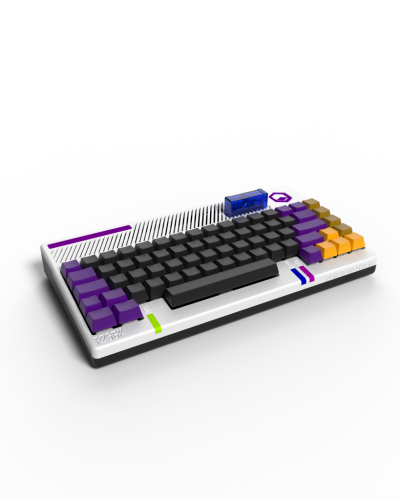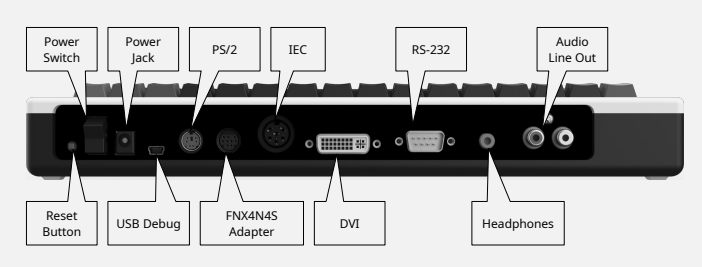Difference between revisions of "F256K"
Jump to navigation
Jump to search
HaydenKale (talk | contribs) (Add 'Kernels' section) |
HaydenKale (talk | contribs) (Add "ports and connectors" section) |
||
| Line 14: | Line 14: | ||
[[File:f256k_Secondpass.6-819x1024.png|400px]] | [[File:f256k_Secondpass.6-819x1024.png|400px]] | ||
| + | |||
| + | = Ports and connectors = | ||
| + | |||
| + | The back of the unit looks like this: | ||
| + | |||
| + | [[File:f256k_rear_connectors.PNG]] | ||
| + | |||
| + | * '''Power Switch''' is a toggle-style switch to turn the unit off and on. | ||
| + | * '''Reset Button''' reboots the system, with values in RAM persisting. If RAM has been modified using the debug interface, it stays modified. | ||
| + | * '''Power Jack''' is for plugging in A/C power. Use, for example, a +12V or +9V with 2.5mm Barrel connector. | ||
| + | * '''USB Debug''' is for connection to a debug host computer, debugging F256k as a target, for example using a mini USB to USB A cable. | ||
| + | * '''PS/2''' can be used for connecting external keyboard and/or mouse. | ||
| + | * '''FNX4N4S Adapter''' provides connections to gamepads (e.g., SNES-style game controller) through the FNX4N4S adapter. | ||
| + | * '''IEC''' provides connectivity to Commodore-compatible devices that use serial interface | ||
| + | * '''DVI''' is for connecting a display. | ||
| + | * '''RS-232''' provides a standard RS-232 serial interface. | ||
| + | * '''Headphones''' is a standard 3.5mm headphone jack. | ||
| + | * '''Audio Line Out''' provides stereo audio output. | ||
= Kernels = | = Kernels = | ||
Revision as of 10:36, 25 June 2023
The F256k is a 65xx-based system. It's an encased form factor with a built-in keyboard. It includes the following features:
- 512K of Shared System & Video RAM (256k on the Rev A)
- 256k of flash
- 256k of cartridge ram/rom
- TinyVICKY Graphic Chip (CFP9599)
- 1x Simple 3-wire UART (RS-232 Port, Feather ESP8266 wifi, or Feather MIDI)
- 2x Atari Style Joystick Ports, 1x DB9 to interface to NES/SNES Adapter (For Rev B Only)
- 1x IEC Port to interface to Commodore Drives
- SID sound chip
It shares many similarities to the F256JR and programs may straightforwardly run on both.
The most common variety of the F256k uses the 6502 CPU. That said, the 65816 CPU can also be installed.
Ports and connectors
The back of the unit looks like this:
- Power Switch is a toggle-style switch to turn the unit off and on.
- Reset Button reboots the system, with values in RAM persisting. If RAM has been modified using the debug interface, it stays modified.
- Power Jack is for plugging in A/C power. Use, for example, a +12V or +9V with 2.5mm Barrel connector.
- USB Debug is for connection to a debug host computer, debugging F256k as a target, for example using a mini USB to USB A cable.
- PS/2 can be used for connecting external keyboard and/or mouse.
- FNX4N4S Adapter provides connections to gamepads (e.g., SNES-style game controller) through the FNX4N4S adapter.
- IEC provides connectivity to Commodore-compatible devices that use serial interface
- DVI is for connecting a display.
- RS-232 provides a standard RS-232 serial interface.
- Headphones is a standard 3.5mm headphone jack.
- Audio Line Out provides stereo audio output.
Kernels
There are three kernels for the F256k.
- The TinyCore MicroKernel (ships with the unit)
- OpenKERNAL (for those wishing to run software written for the CBM KERNAL)
- FoenixKERNAL, an open source, CBM-style layer also compatible with software written for Commodore 64 KERNAL

